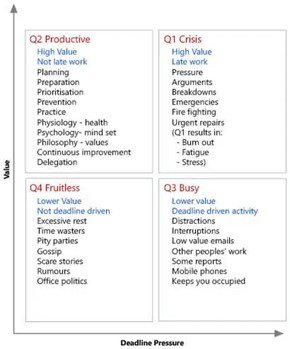How to Prioritise Tasks Effectively
How To Prioritise Tasks Effectively
There are two groups of people who need to know how to prioritise: Those who want to achieve their highest levels of productivity, and those who feel overwhelmed by the sheer volume of their work.
Those who want to achieve more productivity need to prioritise because, not all tasks have equal value, and those interested in making progress, need to focus their efforts onto those tasks that add the most value.
In addition, everyone is "a limited resource, facing an unlimited demand". It is impossible to do everything, so we should abandon the attempt and instead, learn to prioritise.
Prioritisation is the art of putting things into the right order.
It can be done by means of two methods:
- Prioritisation by reference to Value and Deadline pressure.
- Prioritisation by reference to Logical sequence.
Let us look at each method in turn:
1. Prioritisation by reference to value and deadline pressure.
Each task may be judged according to two fundamental criteria, its Value (high to low) and its Deadline Pressure (high to low). These two criteria can be used as the basis of a model that produces four categories of work. Please study the grid below.

Tasks should be done in order that approximates to the numbering on the grid, that is:
Q1 Crisis, emergency, "all-hands-on-deck" activity, must take precedence over...
Q2 Long-range, high value, Productive, preventative activity, which should take precedence over...
Q3 Lower value, "busy but non-productive" work, which takes precedence over...
Q4 Lower value, fruitless or waste of time activity.
We should spend the majority of time in Q2 activity: The High Value, but NOT YET late, category of work, which includes, planning, preparation, practice, prevention, problem solving activities.
Failure to do Q2 prevention, preparation, and planning creates the conditions for next month's batch of Q1 Crises.
Beware the Q3 Busy Zone: The most common mistake is that people spend too much time in the "Q3 Busy but non-productive Zone", which denotes all the time people spend working hard, on trivial things that don't add much value, nor get them closer to their goals.
This is the most common error, and most people make it every day.
The solution is to limit time spent in Q3 busy work: Minimize the time spent in "Q3 busy zone" and transfer it over to "Q2 Productive zone" which is defined as, "High value, long range, preventative activity".
What is the most valuable use of my time, right now?
The key concept is VALUE. If we want to succeed, then every day, we must do the most valuable things: NOT the easiest things, not the most pleasant things, but rather, the most valuable things.
How can we determine what is the most valuable thing?
We have created a Prioritisation APP which you can use, to determine the most valuable use of your time. Please follow this link to gain access to the prioritisation APP.
2. Prioritisation by reference to logical sequence.
The second method of prioritisation is by reference to "logical sequence".
Every task is composed of a larger number of subset tasks, which should be done in their most logical sequence. Every task has an ideal, most efficient sequence which if followed, would be the optimum sequence and therefore, the most productive.
Even simple tasks, such as getting dressed in the morning has a definite sequence; you always put your socks on before your shoes, you always put your shirt on before your jacket.
It is not enough to do the right things; we must also do them in the right order.
If you mess up the logical sequence of any task, then the tasks become inefficient or it fails completely.
In order to organise sequencing, then ask and answer the following question:
Which of these tasks, should logically come first?
Keep asking yourself questions about logical sequencing, which is sometime called, "Critical path analysis" and try to get the sequencing logically right.
Combining methods of prioritisation.
Whenever you are prioritising tasks, there are three questions to consider:
- Which tasks are the most valuable?
- Which have the greatest deadline pressure?
- Which tasks logically MUST be done, before the other tasks CAN be done?
Definition: Value-Deadline Matrix
The Value-Deadline Matrix is a simple time-management model. It places each task on a four-box grid by judging its value to the goal and the time left before the deadline. This view shows which tasks are crises, which are high-value early work, which are low-value chores and which are waste, so you act in the best order.
Show CG4D Definition
- Rates every task on two factors: value and deadline pressure.
- Forms four quadrants (Q1–Q4) that set clear priority order.
- Guides focus to high-value, not-yet-urgent work after crises are handled.
- Flags low-value busy or waste tasks for delay or removal.
Article Summary
To master time, stop trying to do it all. Judge each job by value and deadline, act first on high-value items before they turn urgent, and set the steps in the right order. By moving hours from low-value busy work to planned Q2 tasks, you gain calm, speed and real results.
Frequently Asked Questions
Here are some questions that frequently get asked about this topic during our training sessions.
What is the Value-Deadline Matrix in task prioritisation?
How do I place a task into Q1, Q2, Q3 or Q4?
Why should I spend most of my time on Q2 tasks?
How can I spot low-value busy work quickly?
Which daily questions help me prioritise tasks?
How does logical sequence differ from value-based ranking?
What happens if I ignore preventative Q2 activity?
Thought of something that's not been answered?
Did You Know: Key Statistics
The 2024 Microsoft Work Trend Index shows that the average office worker spends 57% of the working day on email, chat and meetings, leaving only 43% for deep work that moves projects forward. Asana’s 2024 Anatomy of Work report finds that staff who set clear daily priorities save an average of 6 hours each week and are 2.3 times more likely to meet project deadlines.Blogs by Email
Do you want to receive an email whenever we post a new blog? The blogs contain article 5-10 minutes long - ideal for reading during your coffee break!
Further Reading in Time Management
-
How to be More Efficient and Effective.
Learn practical time management steps to boost work efficiency: goal setting, task priority, smart sequencing, good-enough action, delegation and balanced rest.
Read Article > -
The 80/20 Rule - Pareto Principle - Explained
Learn how the 80/20 rule helps you spot the few tasks that drive most results, cut busywork, and boost work efficiency, time management and business productity.
Read Article > -
Managing Stress
Learn how time management and healthy habits reduce stress, control workload and build a positive mindset. Gain focus and delegate tasks with smart planning.
Read Article > -
How to plan your time effectively
Learn time management: plan ahead, focus on top goals, set priorities, delegate tasks and keep a tidy workspace to boost productivity and control your day.
Read Article > -
What is Wrong With Multitasking?
Learn why multitasking drains mental energy, lowers focus and slashes productivity. Discover how single task time management boosts work quality and efficiency.
Read Article >
Looking for Time Management Training?
If you're looking to develop your Time Management Skills, you may find this Time Management Training Course beneficial:
Open Training Course Pricing and Availability
Next Open Course Starts in 32 days, Cheltenham Gloucestershire, places available






